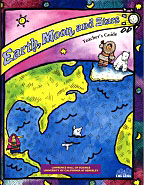Earth, Moon, and Stars
Grades 5—8
Written by Cary I. Sneider
If the Earth is a ball, why does it look
flat? Why does the moon change its shape? How can I find constellations
and tell time by the stars?
In this research-based unit, students
answer these and other questions and learn a great deal about
the Earth, gravity, and astronomy. Sections focus on the shape
of the Earth and gravity; moon phases and eclipses; and the
stars. In activities that involve real-world sky gazing, students
observe and record changes in the sky and create models to explain
their observations. A challenging questionnaire on the EarthÝs
shape and gravity can be used as a pre- and post- assessment
tool.
Independent research has found this unit particularly effective
in helping students unravel their misconceptions about the Earth's
shape, gravity, orbit, and relationship to the rest of the universe,
and create a more accurate model of the world. Details of this
study are available on the page "Educational
Effectiveness of GEMS."
This wide-ranging interdisciplinary unit also connects to world
cultures through its exploration of myths about the rising and
setting of the sun. It makes an exciting astronomical connection
to the GEMS guides Messages
from Space and Moons
of Jupiter.
Time: Six 40- to 45-minute sessions; four 20- to 30-minute sessions;
six 15-minute sessions.
See the Earth, Moon, and Stars online
orientation video.
Comment on this GEMS unit.
|

Out of Print
Ordering information
Literature Connections
Does Earth rotate?
Spanish Language Student Materials
What materials are needed to present this unit? See the full list. |

